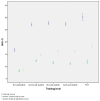Simulation-based multiple-choice test assessment of clinical competence for large groups of medical students: a comparison of auscultation sound identification either with or without clinical context
- PMID: 26451229
- PMCID: PMC4563623
Simulation-based multiple-choice test assessment of clinical competence for large groups of medical students: a comparison of auscultation sound identification either with or without clinical context
Abstract
Background: Although simulation-based teaching is popular, high-fidelity, high-cost approaches may be unsuitable or unavailable for use with large groups. We designed a multiple-choice test for large groups of medical students to explore a low-cost approach in assessing clinical competence. We tested two different scenarios in assessing student's ability to identify heart and lung sounds: by hearing the sounds alone, or in an enhanced scenario where sounds are incorporated into clinical vignettes to give clinical context.
Method: The two-section test consists of multiple-choice questions with one best answer. In the first section, the student must identify 25 auscultation sounds from amongst a choice of 14 heart sounds and 11 lung-sounds. The second section integrates these same sounds into clinical vignettes to provide clinical context. Students must either identify the illness or the next clinical step, choosing from four possible answers. Performances of 859 students were evaluated.
Results: The alpha coefficient of reliability is 0.54 and 0.76 respectively for the first and the second section. In the latter section there is significant difference between scores of first, second, fourth year students and residents, in contrast to the first-section scores.
Conclusions: A multiple-choice test to assess clinical competence based on simulated auscultation sounds incorporated into clinical vignettes allows us to differentiate between training levels and seems to be a valid assessment method suitable for large-group format.
Figures
References
-
- Weller J. Simulation in undergraduate medical education: bridging the gap between theory and practice. Med Educ. 2004;38(1):32–38. - PubMed
-
- Issenberg SB, McGaghie WC, Hart IR, et al. Simulation technology for health care: professional skills training and assessment. JAMA. 1999;282:861–866. - PubMed
-
- McGaghie WC, Issenberg SB, Petrusa ER, Scalese RJ. A critical review of simulation-based medical education research: 2003–2009. Med Educ. 2010;44:50–63. - PubMed
-
- Issenberg SB, McGaghie WC, Petrusa ER, Gordon DL, Scalese RJ. Features and uses of high-fidelity medical simulation that lead to effective learning: a BEME systematic review. Med Teach. 2005;27:10–28. - PubMed
-
- Hatala R, Kassen BO, Nishikawa J, Cole G, Issenberg SB. Incorporating simulation technology in a Canadian Internal Medicine specialty examination: a descriptive report. Acad Med. 2005;80:554–556. - PubMed
LinkOut - more resources
Full Text Sources

